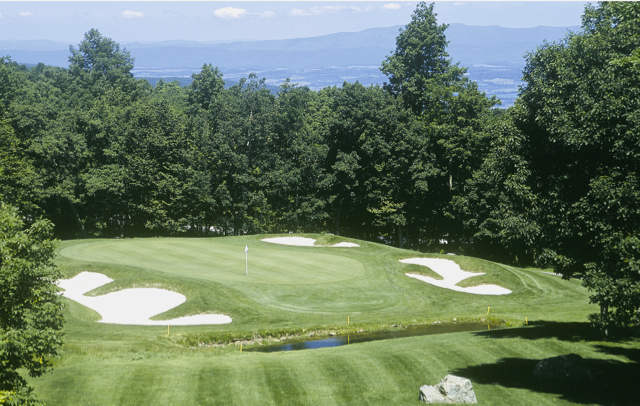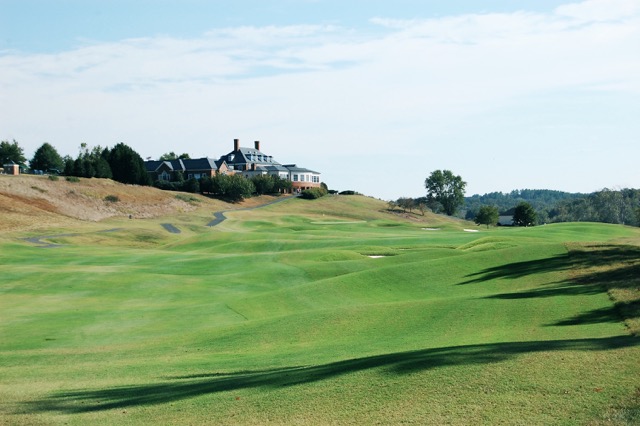Charlottesville, VA, is one of the most underrated golf community markets for retirees. Perhaps a perception that a state just below the Mason-Dixon Line and not far from the Blue Ridge Mountains suffers through long, cold winters keeps us Yankee retirees from showing this impressive college town the love it deserves. In truth, those who live in the Charlottesville area put away the golf clubs in January and February but the weather generally cooperates in December and March and is nearly perfect the rest of the year. And in January and February, there are plenty of distracting events in a major college town like Charlottesville, home to the University of Virginia (UVA), including big-time college basketball, concerts and art exhibits. And the university’s adult education program is on a par with any in the nation.
More and more, there are signs that retirees are discovering the quality of golf living in and around this particular college town. In November, the number of sales of homes in the counties surrounding the city rose as much as 83%, in Nelson County, home to the Wintergreen Resort. At the same time, the median sales price of homes in Nelson County, the vast majority of them inside the boundaries of the ski and golf resort, was up a robust 29% while inventory had dropped 10%, evidence of the rule of supply and demand at work. My family and I have stayed at the Wintergreen Resort a couple of times and found the golf outstanding and the views of the Blue Ridge Mountains stunning (an entrance to the famed Blue Ridge Parkway is just outside the gates of Wintergreen). Condos with mountain views start below $200,000; single-family homes, some with impressive views, generally sell from the low $200s. The 45 holes of golf are from the design studios of Ellis Maples (Devil’s Knob, 18) and Rees Jones (Stoney Creek, 27). We’d be happy to put you in touch with Steve Marianella, the agent we work with at Wintergreen. (Note: The Devils Knob golf course at the top of the mountain, whose first tee is a short stroll from the top of the ski lift, closes during winter months, but the Rees Jones 27 holes at the foot of the mountain remain open, providing the unique possibility on some days of skiing in the morning and golf in the afternoon.)
The views from the 17th at Devil's Knob are impressive, as are the views on the
rest of the course, designed by Ellis Maples.
Wintergreen is located an hour west of the city of Charlottesville. The community of Glenmore in Keswick, VA, is about 25 minutes to the east, on the way toward Richmond. The golf course, designed by John LaFoy, rises and falls along sweeping fairways through the community of indigenous, mostly brick homes set well above the funneled fairways. That provides great views from many backyards yet little intrusion on the field of play for golfers. Given the community’s Scottish name and landscaping, LaFoy’s layout could fit comfortably into parkland in the Old Sod. Few lots remain for sale at Glenmore, and current resale homes start around $500,000. Tom Pace is our agent contact for Glenmore (he and his family live there) as well as Keswick Estates (see below).
The clubhouse behind the 18th at Glenmore is a solid and welcoming sight after a
round at the John LaFoy layout in Keswick, VA.
Just a couple of miles from Glenmore, Keswick Hall Golf Club, in the heart of Keswick Estate, has captured the attention of the luxury golf home market in the area for the last two years, ever since Pete Dye redid a decent but underachieving layout by the Arnold Palmer design firm. It is hard to think of Dye, given his reputation, having “softened” the hard edges on anyone’s layout, but he has been given strong credit for doing just that at Keswick Hall without diminishing the challenge. At completion, Keswick Estates will comprise just 121 homes, with lots priced today beginning at $290,000 and resale homes, big and beautiful, for sale starting above $1.2 million.
Other golf community options in the Charlottesville area include Old Trail in Crozet, just west of the city, with a mix of condos, town homes and estate homes at prices starting in the high $300s, and a golf course that is both reasonably priced (semi-private) and challenging. Farmington Golf Club is the staid old style club in the area, with a clubhouse designed by Thomas Jefferson and a golf course that has lots of classic touches. If you would like information on any of the Charlottesville golf communities or more information on the area itself, please contact me.























